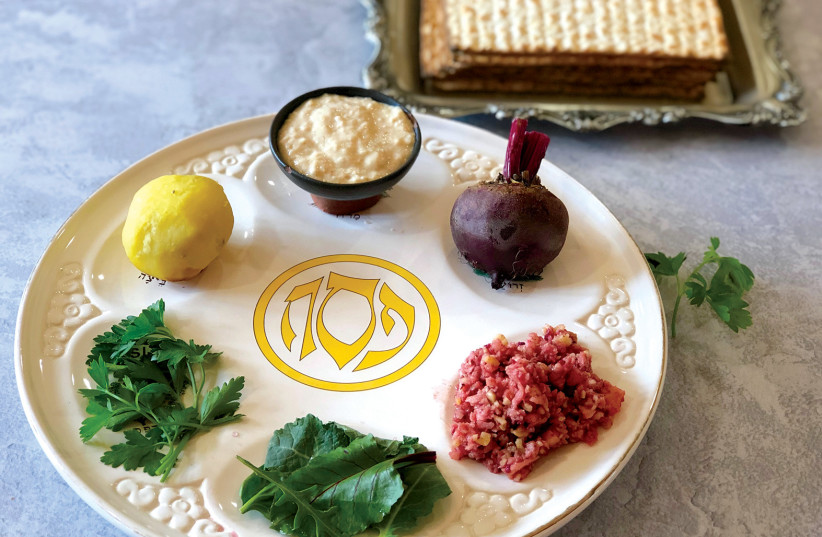Eitan Ashman, a 48-year-old resident of Efrat, suffered a massive stroke in the middle of the night, nearly six years ago. Prior to his stroke, Ashman, husband to Leora and father of four, ran his own property management business, was an active Magen David Adom volunteer, a CrossFit instructor, and taught Torah in his local synagogue.
All that ended suddenly when Leora found Eitan, who had been in peak physical condition with no family history of illness, on the floor of their kitchen, felled by a stroke.
After eight months of rehab, Eitan was left with Broca’s aphasia, a side effect of his stroke that makes it hard for him to communicate, let alone lead a Passover Seder, as he once did with ease.
Perhaps more than any other Jewish tradition, the Passover Seder is a speaking event. The word “Pessah” (Passover) is a contraction of two Hebrew words, peh and sah, which translate as “a mouth that speaks,” and “Haggadah” comes from the Hebrew verb “to tell.”
So how could Leora, the family, and the community help Eitan participate in the family Seder?

As Leora wrote in the Haggadah’s introduction, “With the guidance and intuition of Rabbi Johnny Solomon, the insights and reflections Eitan had written in the years prior to his stroke were revised and condensed into simpler, shorter ideas that Eitan could more easily share and read aloud.”
From these notes, the Ashman family created a simple, spiral-bound Haggadah booklet that unwittingly became the prototype for the Empowering Seder Conversations Passover Haggadah.
The feedback the family received from the prototype was surprising. The Ashmans learned that people with language challenges that went way beyond aphasia benefited from the concise language of their Haggadah booklet. These included children who were reluctant to read from a traditional Haggadah, people who stutter, individuals with reading disabilities and attention deficit challenges, and the elderly.
Those new to Torah observance and non-native English speakers can also benefit from the straightforward language employed in the Haggadah.
Contributing to the Haggadah for an inclusive Seder
Although a desire to include Eitan in the Seder in a meaningful way was the original impetus, the Empowering Seder Conversations Passover Haggadah expanded far beyond the humble prototype.
It includes contributions from 35 Torah scholars, friends, and those Leora calls “heroes who contribute beautiful and inspiring pieces of Torah while facing daily speech, language, and disability struggles.” Each of these commentaries is brief and written in simple language.
Among the most poignant contributors are Maia Dee, who, along with her mother, Lucy, and sister Rina, was murdered in a terrorist attack on Passover 2023; and Ari Fuld, who was fatally stabbed by a terrorist in 2016. Both Dee and Fuld lived in Efrat.
The book’s design is as much a part of the Empowering Seder Conversations Passover Haggadah as its contents. Both the Hebrew text and the English commentary are printed in large font to facilitate easier reading. A system of icons is used to describe the order of the Seder and the actions that need to be taken at each stage.
At first glance, the front cover art, created by Israeli artist Yael Harris Resnick, looks like the splitting of the Red Sea. In reality, the image contains a hidden face. On closer examination, the right side of the sea shows a face in profile. As Leora Ashman explained, the symbolism of the hidden face is that you can’t always see disabilities, such as aphasia.
Arguably, the most distinctive and universally applicable feature of the Empowering Seder Conversations Passover Haggadah is the set of Seder Inclusion Tools. These are 13 ideas for encouraging the inclusion of all Seder participants, no matter what level of communication they bring to the table.
The Seder Inclusion Tools include such courtesies as finding out in advance which participants are willing to be called upon to read aloud, and a list of seven do’s and don’ts for engaging people with different levels of ability. The list of tools also encourages the Seder leader to weave in multisensory experiences such as visuals, song, gestures, and movement to aid those with communication impairments.
You may already have a shelf full of Haggadot. But if you plan to have anyone with any kind of communication challenge at your Seder table this year, the Empowering Seder Conversations Passover Haggadah is a must-have.
The writer is a freelance journalist and expert on the non-Jewish awakening to Torah happening in our day. She is the editor of Ten From The Nations and Lighting Up The Nations.
- EMPOWERING SEDER CONVERSATIONS PASSOVER HAGGADAH
- By Eitan Ashman and Contemporary Jewish Voices
- Urim Publications
- 128 pages; $29
